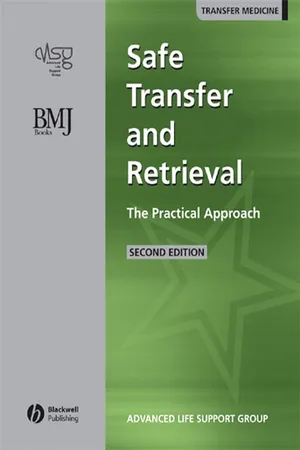
- English
- ePUB (mobile friendly)
- Available on iOS & Android
About This Book
The safe transfer of all hospital patients, especially those who are critically ill, is of crucial importance, demanding organisational, as well as clinical skills.
Safe Transfer and Retrieval of Patients (STaR) is aimed at all health care workers involved with inter and intra-hospital transfers. It provides a much needed structured approach to transfer medicine, together with sound guidance on relevant clinical procedures.
The second edition has been extensively revised in line with new developments in transfer medicine. The book has been redesigned with five distinct sections covering:
- the principles of the STaR structured approach to transfers
- the management of the transfer or retrieval
- practical procedures related to transfer medicine
- an overview of clinical care during the assessment and stabilisation phases of transfer.
- the legal and safety aspects of transfers, specific differences in helicopter transfers and transfers involving children
A new chapter, the infectious or contaminated patient, has been added, in light of current concerns around the potential transfer of infection between patients and staff.
The major revisions to this STaR coursebook bring it into line with the latest thinking on patient transfers, making it an invaluable guide for anyone involved in this aspect of health care.
Frequently asked questions
Information
PART I
Introduction
Chapter 1
Introduction
- Organisational and management strategy
- Practical problems that may be encountered during preparation, packaging and transportation of patients
Box 1.1 Primary diagnosis in transferred patients
- Asthma
- Neurological condition
- Status epilepticus
- Meningitis
- Diabetes
- Cancer
- Eclampsia
Box 1.2 Transferring departments
Box 1.3 Most commonly reported adverse events
- No capnography available (when clinically indicated, with potential for raised ICP)
- Cardiovascular instability during transfer
- Tachyarrythmias/bradycardias
- Hypotension
- Hypertension
- Hospital equipment problems
- Monitor failure
- Pump failure
- Equipment not available
- Mechanical ventilator not available
- Significant hypoxia
- Ambulance breakdown/lost en route
- Cardiac arrest in ambulance
- Death in transfer
Table of contents
- Cover
- Title Page
- Copyright
- Working groups
- Contributors
- Preface to the second edition
- Preface to the first edition
- Acknowledgements
- Contact details and website information
- PART I: Introduction
- PART II: Managing the transfer
- PART III: Practical aspects of transfer medicine
- PART IV: Assessment and clinical aspects of transfer medicine
- PART V: Special considerations
- PART VI: Appendices
- References and further information
- Glossary
- Index
- EULA